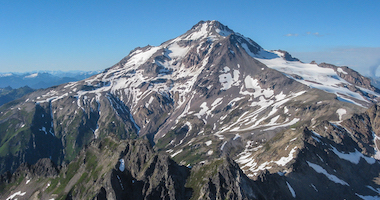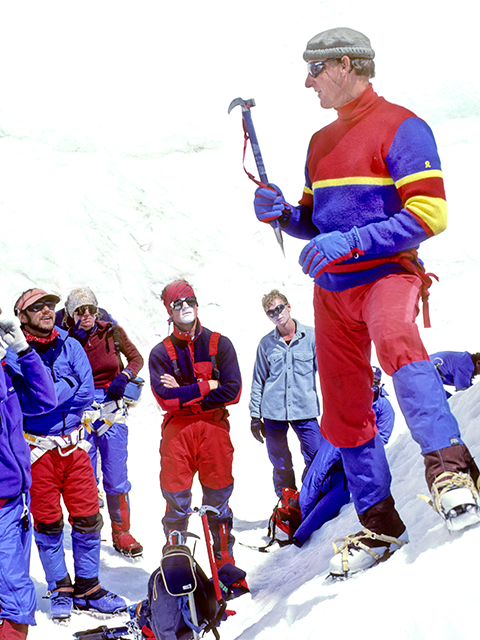Most Popular Entries
Posted by: Pete Van Deventer, Matias Francis, Chase Halbert
Categories: Expedition Dispatches Mt. McKinley
Elevation: 11,000'
Monday, May 24, 2021 - 10:45 pm PT
Today was quite possibly the nicest day in the Alaska range that any of the guide team can remember. The last several days earned us a perfect, clear, calm day and as such the expedition cogs were churning all over camp. Teams that have been waiting to move to 14,000' Camp were busily taking down camp and teams that have been waiting to cache were saddling up to go. We already had packs loaded, so a quick breakfast got us going and then we were finally, FINALLY, climbing. The whole team climbed really strong, enjoying the chance to stretch our legs. A few stretches of walking got us to our cache location at 13,500', where we unloaded food and fuel, then enjoyed a light, quick jaunt back down to our 11,000' Camp. All told we had an easy six hours round trip. The forecast sounds like it's holding, so our intention tomorrow is to retrace our steps in the morning and head to our next home at 14,000'.
RMI Guides Pete, Chase, Matias, and team
Posted by: Casey Grom, Billy Nugent
Categories: Expedition Dispatches Mount Rainier
Elevation: 14,410'
Congratulations to everyone on the Team!
Aeron, we are so proud of your commitment and success !!
Posted by: Mom &Dad; on 8/9/2013 at 6:05 pm
We’re all so proud of you, Ian. How was the view from the top? :-D
Posted by: Roland on 8/9/2013 at 10:56 am
.jpg)
Lis and Pete,
We are very proud of your endurance and stamina.
Wishing you and the team sunny skies for the remaining part of the trip.
Nicole
Posted by: Nicole areson on 5/20/2013 at 10:32 am
So glad the weather has cleared! The photo is awesome, I can’t wait to see the final pics of this spectacular region. Godspeed and I hope that the weather cooperates the rest of the week. JIm Vaughan
Posted by: jim vaughan on 5/19/2013 at 7:26 pm
Do hope there is enough Kungfu chicken to go round…
Take good care all of you, stay happy and healthy and get there!!
Posted by: Claire Munting on 7/12/2011 at 6:39 pm
HEY SPENCER HOLD ON THERE TONTO WEST AND I ARE ON THE WAY WITH FRESH LINENS AND MORE COFFEE AND A LATTE. HEY AND WOULD YOU LEAVE YOUR LEFT OVER STUFF WHERE WE CAN FIND IT. YOU KNOW US JUST KIDDING!!!!PRAY FOR THE BEST WEATHER FOR YOU AND YOUR TEAM. GET TO THE SUMMIT!!!!
Posted by: TOBY EMERSON on 7/12/2011 at 1:58 pm
Posted by: Jess Wedel
Categories: Expedition Dispatches Everest BC Trek and Lobuche
Elevation: 17,575'
Out here, we remember to marvel. It’s so easy to forget how incredible this planet is but when you wake up to go to the bathroom in the middle of the night at 17,500 ft and you are surrounded by a world of stars you can’t help but be in awe. That’s what these last two days have been like. We are amazed at the power of the ice and the glaciers around us, we can’t get enough of the stars at night, and base camp — to see a whole city built of tents in such a harsh and unforgiving place is pretty incredible.
Today we got to walk to the lower Khumbu ice fall and do some ice climbing and training for Lobuche. We learned how to use our ascenders (safety first!), how to rappel and how to climb training for Lobuche. We learned how to use our ascenders (safety first!), how to rappel and how to climb steep ice and snow.
I’m so impressed with everyone on this team and so excited to see what Lobuche has to offer us these next few days.
RMI Guide Jess Wedel and the climbing team
New Post Alerts:
Everest Base Camp Trek & Lobuche, March 16, 2024
Posted by: Steve Gately, Ben Ammon, James Bealer
Categories: Expedition Dispatches Mt. McKinley
Elevation: 14,200'
On The Map
Cheering for all of you guys and crossing fingers for a great summit weather over the next few days!
Posted by: Anna on 5/28/2019 at 3:49 am
On The Map
Tear it up!! You are doing something I always dreamed of doing.
Posted by: Phil Kostrzewski on 3/25/2015 at 8:07 pm
Posted by: Dave Hahn, Billy Nugent, JJ Justman
Categories: Expedition Dispatches Everest
Elevation: 11,200'
Nicole and Team,“The Lord is your shepherd” and He will lead you on your journey. We will follow you each day with our joy, energy, excitement and love. Mimi
Posted by: marianne rhodes on 3/30/2014 at 5:09 pm
Nicole, I am glad your team is rested and ready to go forward together. From now on is the exciting experience that we have spoken about so many times. You are an inspiration to your friends and family. I know you will accomplish with the entire team with you. You know your mom is proudly supporting you as well and with you in spirit. Love you much A.Ginny
Posted by: Ginny Marasco on 3/30/2014 at 7:35 am
Posted by: Seth Waterfall, Solveig Waterfall
Categories: Expedition Dispatches Mexico
Elevation: 17,340'


Seth Waterfall calls from the Ixta summit!
On The Map
Wow you met your goal!!!you must be on top of the world. We are thrilled for you Ryan. You are truly amazing.
Praying for you and the team..
Love you,
Proud mom&dad;
Posted by: nancy mccalley on 2/13/2013 at 9:22 pm
Congratulations to the entire team and guides for your summiting. I’m especially proud of Brandon, and I know this has been an awesome experience for him.
Posted by: Brad Grooms on 2/13/2013 at 11:40 am
Congrats to Frank and the whole team! Great job on a bigggg mountain!
Posted by: Tony Horness on 7/11/2011 at 7:41 am
We are all anxiously awaiting your return, but BE SAFE! A big hug to Frank.
Posted by: Laurie M on 7/9/2011 at 12:17 pm























Glad you see you got to move again today!
Posted by: Sheila on 5/25/2021 at 8:52 pm
Wow this is amazing to “watch”! Praying for the whole team’s success. You got this, Matt! Enjoy every step.
Posted by: Linda Baker on 5/25/2021 at 5:41 pm
View All Comments